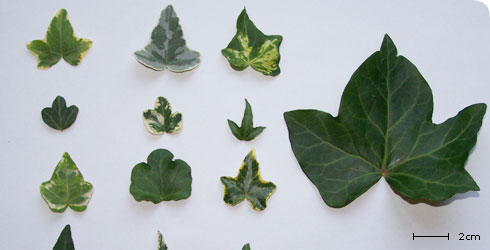Taxonomy
Ivy belongs to the Araliaceae, or ginsengs, a mainly tropical family of trees, shrubs, woody lianes (vines) and a few herbs.
The ivy genus, Hedera, has recently been expanded to contain 15 species, but not all botanists agree. The similarities between the species are reflected in the fact that all have, at some time or another, been viewed as variants of Hedera helix.
Description
Ivy is a woody, evergreen climber. In suitable conditions it can reach 30m high with stems up to 25cm in diameter, but it can also creep along the ground.
The stems are clothed in hair-like roots which are adhesive, enabling the plant to cling to hard surfaces.
The leaves are:
- hairless
- dark green above
- pale green beneath
- glossy
- rather leathery
Leaves on creeping or climbing stems have blades with 3 to 5 triangular lobes, whereas those of flowering branches have oval or rhombic blades, without lobes.
The flowers are borne in umbrella-like clusters, with all the stalks arising from a single point. They have 5 broad greenish yellow petals 3–4mm long and are followed by globose, dull black fruits which ripen in the following spring.
When rubbed, the berries have an aromatic scent but a bitter and nauseous taste.
There are hundreds of cultivars of ivy, mainly differing in their leaves which are very variable in size, colour, number and depth of lobes. The leaves are often variegated green and any one of a wide range of colours but particularly white, cream, yellow or gold. They are popular as garden ornamentals and as house plants.
Several plants can be confused with ivy, mainly because of their names. Two are found in North America and are completely unrelated to ivy. They are:
- Boston ivy (Parthenocissus tricuspidata) - a climber with lobed leaves that is a member of the grape family. It is deciduous and clings by means of tendrils with small suckers.
- Poison ivy (Toxicodendron radicans) - this grows as a climbing vine or a small shrub with leaves divided into three leaflets. The sap contains a compound which causes an irritant rash when any part of the plant is touched.
Another species that can cause confusion is ground ivy (Glechoma hederacea) - this is a European herb related to the mints which was used to brew ale.
